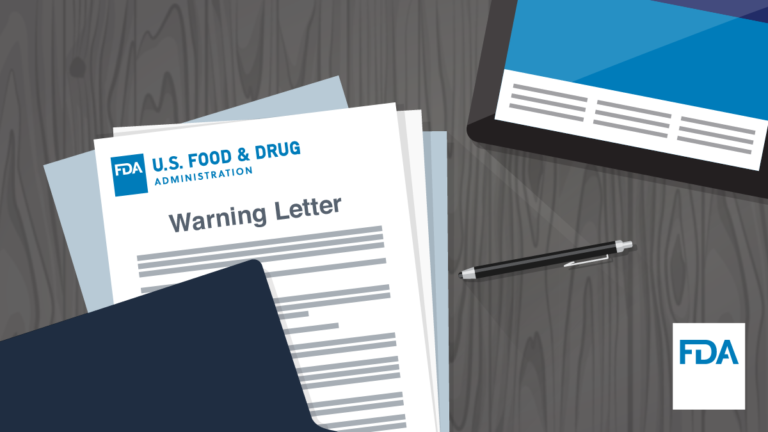Receiving an FDA Warning Letter is always an unpleasant and harrowing experience and best to be avoided if at all possible. For the impacted company, the consequences of a warning letter usually result in improvements – but this is not the ideal way to make such improvements. Warning letters are public documents and, as such, provide great learning opportunities to see how FDA approaches different components of compliance. They also provide an opportunity for all of us to see where FDA is placing its priorities and what the regulatory expectations actually are. Thus the regular review of Warning Letters received by other manufacturers can be a good opportunity for your own improvement – without the negative side effects.
One such recently published Warning Letter illustrates these points and cites sections of the FSMA Preventive Controls Rule. One learning point from the warning letter is FDA’s focus on having a good hazard analysis, while another section speaks to the requirement that ready-to-eat food establishments have written environmental monitoring programs and follow the plan. Following are three key takeaways from the letter related to environmental monitoring and control:
- Hazard Analysis. Citing 21CFR 117.130(a)(1), FDA stated that the facility did not identify and evaluate all known or reasonably foreseeable hazards to determine whether there are hazards requiring a preventive control for the RTE food.
The regulation states that manufacturers must conduct, and document, a hazard analysis as part of its Food Safety Plan to identify and evaluate known or reasonably foreseeable hazards for each type of food manufactured, processed, packed, or held at the facility to determine whether there are any hazards requiring a preventive control. During inspections, FDA will review both the written plan and its implementation. The facility can then be cited If the plan does not identify all hazards requiring a preventive control that FDA sees as needed or if the plan includes steps that have not been implemented in the facility (see #2 below).
2. Identifying Hazards requiring a preventive control. The facility’s RTE food was exposed to the environment after the mixing step, but was observed to have not received a lethal treatment or other control measure at that point that would significantly minimize pathogens. Thus, contamination with environmental pathogens would be a known or reasonably foreseeable hazard. However, the facility’s hazard analysis did not consider contamination with environmental pathogens as a potential food safety hazard at this step, thus did not evaluate whether it requires a preventive control.
As specified in 117.135 Preventive controls, facilities must “identify and implement preventive controls to provide assurances that any hazards requiring a preventive control will be significantly minimized or prevented and the food manufactured, processed, packed, or held by your facility will not be adulterated.”
Stating that preventive controls include procedures, practices, and processes to ensure that the facility is maintained in a sanitary condition adequate to significantly minimize or prevent hazards such as environmental pathogens, the letter cites 21 CFR 117.135©(3) which details requirements for sanitation controls. As a critical aspect of the environmental control program, sanitation is to include procedures, practices, and processes for the cleanliness of food-contact surfaces, including food-contact surfaces of utensils and equipment; prevention of allergen cross-contact and insanitary and raw-to-processed food cross-contamination.
3. Following on the previous citation, FDA stated, “when contamination with environmental pathogens is a hazard requiring a prevention control, you must verify the effectiveness of this preventive control by performing environmental monitoring.” (21 CFR 117.165(a)(3)). Although the facility had an SOP requiring sample swabs at various points of production, it did not identify the number of sites to be tested, the time or the tests conducted, as required by 21 CFR 117.165(b)(3)(iii-v). Additionally, during the inspection, a manager told the FDA investigator that the company does not recognize environmental swabbing as a verification of sanitation controls.
This citation brings up quite a number of issues. Not only was the information on the sampling process insufficient, the fact that a manager told FDA that the swabbing was not recognized as verification pretty much negated the verification compliance at all.
As stated by the cited regulation, facilities must conduct specific activities to verify that preventive controls are consistently implemented and are effectively and significantly minimizing or preventing identified hazards. This is to include environmental monitoring, with the collecting and testing of samples for an environmental pathogen or indicator organism, if contamination of an RTE food is a hazard requiring a preventive control.
Additionally, the regulation requires written procedures for routine environmental testing on the locations from which samples will be collected, the number of sites to be tested, the timing and frequency for collecting and testing, and the test(s) conducted including the analytical method(s) used. As is frequently said, “if it’s not documented, it wasn’t done.” So, it is important be sure your procedures are included in your written Food Safety Plan – and documented when conducted.
Lessons Learned. Warning letters are issued to facilities when FDA inspector observations detect areas of food safety concern. These can often be areas the facility simply overlooked or did not understand as required by the often-complex regulations. To assist industry in developing, implementing, and improving fully compliant food safety programs – and in learning lessons from others, TAG will review the FDA’s weekly Warning Letters on a weekly basis. In each of our newsletters, we will then highlight and assess one letter for which we will provide insights and recommendations.
Watch for the new section, “TAG Lessons Learned from FDA Warning Letters,” in our upcoming newsletters, and contact us should you need any assistance, guidance, or consultation.





